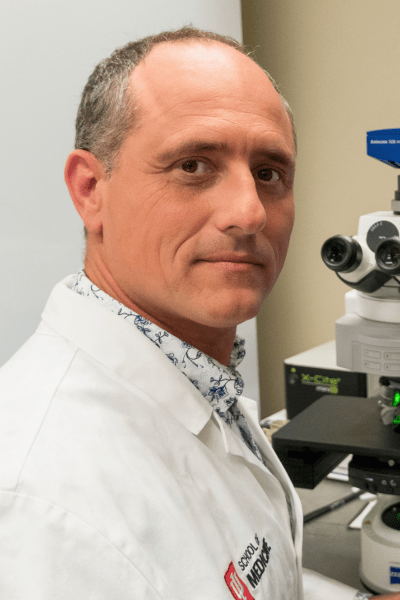
Konstantin Feinberg, PhD
Assistant Professor of Surgery
Adjunct Assistant Professor of Ophthalmology
- kofein@iu.edu
- Address
-
MS 2016
SPLA
IN
Indianapolis, IN
Bio
Konstantin Feinberg, PhD, assistant professor of surgery at the IU School of Medicine, is trained as a biochemist and molecular neurobiologist, with special emphasis on ligand-receptor interaction and cellular communication in the nervous system. Currently, as a co-PI together with Dr. Borschel. Dr. Feinberg’s current research is focusing on mechanisms of neuronal degeneration and regeneration, as well as the role of the corneal sensory innervation in regulation of Limbal stem cells – dependent corneal epithelial renewal.
During his graduate studies he has identified NrCAM as glial protein that, together with gliomedin, induces the clustering of sodium channels, as well as discovered the clues behind the node of Ranvier formation in the peripheral nervous system. During his postdoctoral training, he discovered how to generate functional Schwann cells from human skin-derived mesenchymal stem cells and demonstrated their potential to re-myelinate in Sciatic nerve injury rat model. For his postdoctoral training’s major project, Dr. Feinberg revealed a potent neuroprotective drug that could be repurposed for use as a therapeutic agent for nerve injuries and neurodegeneration and used this drug to identify a previously unknown pro-degenerative feature of a neurotrophic receptor TrkA in sympathetic and sensory neurons.
Key Publications
Key Publications
- Fineberg, K., Fineberg, T., Graessmann, A., Luedtke, N.W., Tor, Y., Lixin, R., Jans, D.A., and Loyter, A. (2003). Inhibition of nuclear import mediated by the Rev-arginine rich motif by RNA molecules. Biochemistry 42, 2625-2633. (in this paper my last name is misspelled)
- Eshed, Y., Feinberg, K., Poliak, S., Sabanay, H., Sarig-Nadir, O., Spiegel, I., Bermingham, J.R., Jr., and Peles, E. (2005). Gliomedin mediates Schwann cell-axon interaction and the molecular assembly of the nodes of Ranvier. Neuron47, 215-229.
- Eshed, Y., Feinberg, K., Carey, D.J., and Peles, E. (2007). Secreted gliomedin is a perinodal matrix component of peripheral nerves. Cell Biology 177, 551-562.
- Grossmann, K., Wende, H., Paul, F., Garratt A., Feinberg, K., Besser, D., Schulz, H., Selbach, M., Peles, E., Birchmeier, W., and Birchmeier, C. (2009). The tyrosine phosphatase Shp2 directs Neuregulin-1/ErbB signaling throughout Schwann cell development. Natl. Acad. Sci. USA 106, 16704-16709.
- Feinberg, K., Eshed-Eisenbach, Y., Frechter, S., Amor, V., Salomon, D., Sabanay, H., Jeffrey, Dupree L., Grumet, M., Brophy, P.J., Shrager, P., and Peles, E. (2010). A glial signal consisting of Gliomedin and NrCAM clusters axonal Na+ channels during the formation of nodes of Ranvier. Neuron 65, 490–502.
- Amor, V*., Feinberg, K*., Eshed-Eisenbach, Y., Vainshtein, A., Frechter, S., Grumet, M., Rosenbluth, J., and Peles, E. (2014). Long-term maintenance of Na+ channels at nodes of Ranvier depends on glial contact mediated by gliomedin and NrCAM. Neuroscience 34, 5089-98.
- Feinberg, K., Kolaj, A., Wu, C., Grinshtein, N., Krieger, J.R., Moran, M.F., Rubin, L.L., Miller, F.D. and Kaplan, D.R. (2017). A neuroprotective agent that inactivates pro-degenerative TrkA and preserves mitochondria. Cell Biology 216(11), 3655
| Year | Degree | Institution |
|---|---|---|
| 2018 | Postdoctoral Training | University of Toronto |
| 2010 | PhD | Weizmann Institute of Science |
| 2003 | M.Sc. | Hebrew University of Jerusalem |
| 2000 | BSC | Hebrew University of Jerusalem |
- Ligand-receptor interaction and cellular communication in the nervous system
- Neuronal degeneration and regeneration
- Corneal sensory innervation in regulation of limbal stem cell-dependent corneal epithelial renewal
Desc: Top Ten Neuroscience Publication of the Year
Scope: National
Date: 2017-09-06
Desc: Research Fellowship
Scope: National
Date: 2012-09-01
Desc: Research Fellowship
Scope: National
Date: 2012-09-01
Desc: Jacob's Ladder Postdoctoral Fellowship
Scope: National
Date: 2012-01-01
Desc: Long-Term Fellowship
Scope: National
Date: 2010-09-01
Desc: The Esther Hellinger Memorial Prize, Excellence in Studies and Research
Scope: University
Date: 2010-01-01